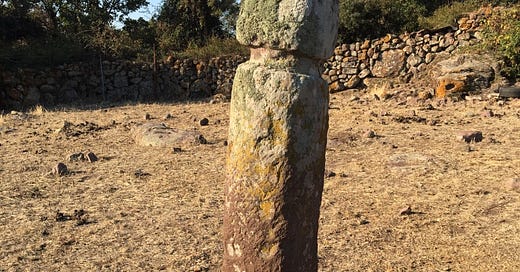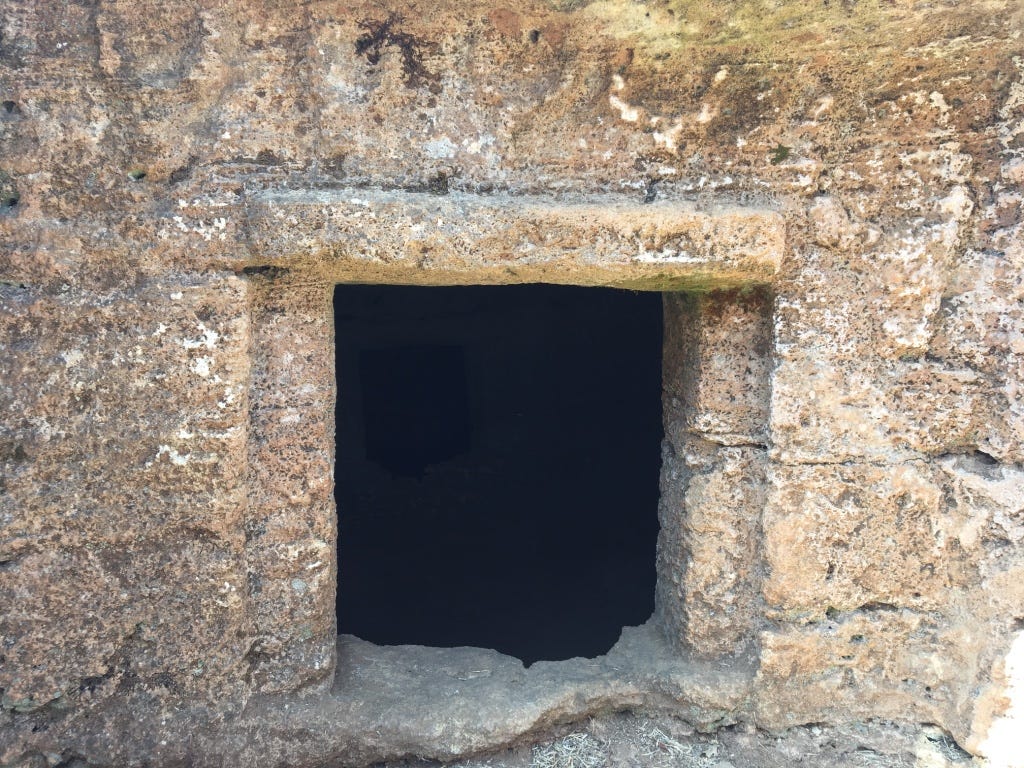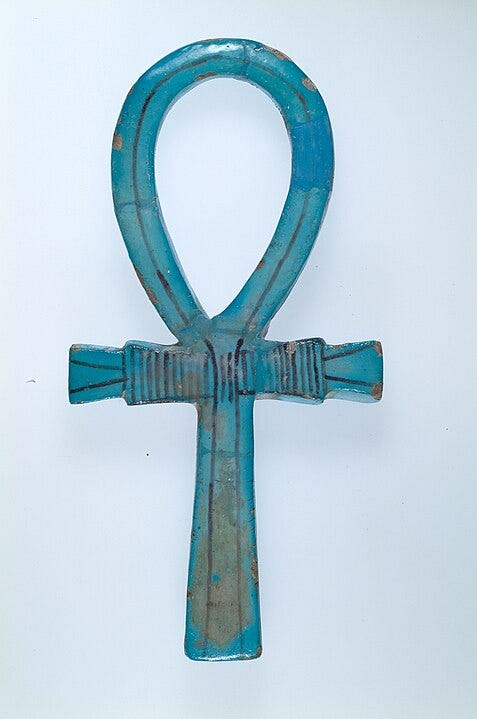A Neolithic menhir (sacred standing stone) of the same type often mentioned in the Christian Bible. Photographed by the author in Sardinia.
The Christian Bible, in both its Old and New Testaments, is absolutely riddled with phallic symbolism. The principal reason why we do not see this powerful truth more clearly is that Christian church leaders have devoted centuries to the project of castrating the phallic gods of Western culture.
And yes, I do mean gods, not God. The anonymous curators, editors and redactors who brought the books, chapters and verses of the Bible together into its current form drew — whether they realized it or not — from multiple religious traditions which happened to be current in Israel-Palestine (not to mention Babylon) in the roughly 650-year span (c. 500 BCE - 150 CE) when the vast majority of the texts included in the Bible were written. As a result, the Bible mentions multiple different names for God, of which the most common, by far, is Adonai — traditionally translated into English as ‘The LORD’. I’ll get back to that shortly, because it’s important.
But for now, a more foundational point: these multiple gods of the Old and New Testament were, by and large, phallic gods. This means, amongst so much else, that they had genitals; that the devotees who worshiped them not only acknowledged their genitals, but specifically worshiped those genitals more than the other aspects of the god; and that these divine genitals had a special, symbolic meaning within not only the specific cult but also the broader culture which surrounded it. Within such broad categories, one can easily find variations on the theme. Specifically, one of the greatest divides among the phallic gods lies between those who are represented as having a phallus, and those who simply are a phallus.
I began the project of The Erotic Gospel on the premise that Jesus Christ was the first type of phallic god — that is, that he has a penis. That in itself is quite radical, in a culture which stalwartly resists any attempt to uncastrate their god. But only now, after months of research, do I realize that Jesus actually belongs to the second type: Jesus not only has a penis; he actually is a penis.
The Female Phallus
The most prevalent misunderstanding about the phallus is that it refers to the male genitalia only. This is untrue. To get the full context around the nature of this nuanced concept, we must step back for a broad view of the (pre)history of Western culture. This is the wheelhouse of the influential and controversial archaeologist, Marija Gimbutas.
Gimbutas, who taught archaeology at UCLA in the latter part of her long career, noted that the oldest known and describable civilizations of Europe and the Middle East placed a much more central emphasis on goddess mythologies than the succeeding cultures which replaced them. Before the wide swath of pantheons which invariably placed a male god at the top while denigrating or even eliminating the goddesses took hold in Europe, the indigenous cultures there gave the place of honor to the Mother Goddess, who birthed all the others — male as well as female. This great Goddess was so powerful that her blessings extended to the realms of death as well as life; in fact, the ancients recognized, just as modern ecology does today, that death is a necessary part of the broader network and dance of the ecosystem. Thus the Mother Goddess held sway over not only life, but also death; in the memorable words of Gimbutas, “the tomb is her womb.”
Take a look at this ancient petroglyph which I photographed in a Neolithic tomb in Sardinia, carved out of the living rock over 5,000 years ago:
Archaeologists call these bucrania — bull’s heads — and it’s not difficult to see why. But there’s more than that going on here; these are complex symbols which also represent the female phallus — the womb. The “horns” are also Fallopian tubes; the “head” is also the womb, tapering to the birth canal from which life emerges.
The Neolithic Sards, who were not anatomically ignorant, used this complex symbol to both bless and ward their tombs. The bucrania, in their male aspect, guarded the tomb and deterred the entrance of evil spirits. In their female aspect, they served as a reminder to the living that this situs of death is also a locus of life.
Though now badly faded by the erosion of time, five bull’s heads can still be seen, adorning the entrance to this rock-cut tomb in Sardinia. The tomb described in the gospels as temporarily holding the body of Christ would have been similar, but with the addition of a movable stone to seal it. Photo by the author.
The Hebrew equivalent to this mythology can be found in the book of Genesis, in the story of Noah’s Ark. The word ‘ark’ — used in the Hebrew Bible to refer not only to Noah’s massive boat but also the vessel which carried the Covenant between YHWH and the Hebrews into the land of Israel — is etymologically related to the Sanskrit word argha, meaning womb. And suddenly the elements of the myth — the gestation of new life, which emerges from the “ark” after a superlatively watery passage — make perfect sense. The Ark, like these Sardinian tombs, represent the mysterious power of the womb — the female phallus.
Without understanding this vital context, it is virtually impossible to understand the phallic significance of the Jesus myth. And not only that — in order to truly penetrate the Christian phallic mysteries, we must also understand the mystery of the Trinity, which is much, much older than Christianity.
The Male Phallus — The Three in One
George Ryley Scott, the learned author of Phallic Worship (and to whom I am much indebted for this present analysis), describes the profoundly phallic nature of the symbolism and myth of the Assyrian Empire. Though many folks today have forgotten this once-vast state, its toponymic influence is still felt: the modern nation of Syria bears its name, though its present political borders may seem puny in comparison to the ancient Empire’s greatest extent.
The Assyrians certainly exercised a violent influence over the people of Israel when the Neo-Assyrian emperor Sennacherib laid waste to the ten “tribes” of the Northern Kingdom; Jerusalem and greater Judah were only spared by the sudden intervention known as the Deliverance, in which (so the Hebrew Bible claims) the angel of the Lord intervened in Sennacherib’s camp, killing mass thousands of his soldiers and forcing him to retreat. Whatever happened that day, there can be little doubt that Syrian influence endured in the land of Israel for many years after that fated invasion.
Which brings me to the subject of the Trinity — a theological concept which was by no means unique to the Syrians, but which the Assyrians probably played a central role in importing into Israel (the other prime suspect being, of course, Egypt).
The divine Trinity — the three-in-one — is a phallic concept, through and through. The most likely template for the Christian Trinity of God-the-Father, Jesus-the-Son, and the Holy Spirit was either the Egyptian Trinity of Osiris-Isis-Horus, or (more likely in Scott’s erudite opinion) the Assyrian Trinity of Asher-Anu-Hoa. In either case it’s a phallic trinity, though in the Assyrian case, the phallic nature of their religion is naked and undisguised. Asher, the root of the name ‘Assyria’, is the erect penis; Anu was the right testicle and Hoa was the left.1 The Trinity, in other words, is a phallic trinity, in which the three parts of the phallus come together to make a whole.2
The patron namesake of the Assyrian Empire was therefore, literally, a penis. (Consequently, the most accurate English translation of the modern name of Syria might well be “Penisland”.) With large carved phalli attached to their spears and shields, the soldiers of the Assyrian army penetrated farther and wider than any empire had ever done before.3
By the time Christianity first emerged in the Holy Land, the phallic influence of the Syrian Trinity had already baked into the soil itself. This is where the point about the honorific Adonai, mentioned at the beginning of this post, becomes relevant: usually translated as “The LORD,” the Hebrew word is actually plural, so that it means “The Lords.” This is a reference to the phallic Trinity, the three in one. As its influence on the traditional Hebrew religion grew, the Trinity found fertile new fields in the realms of the nascent religion which had sprung up around the story of Jesus Christ, who then became a Trinitarian god under its influence.
Which brings me, finally, to the Jesus story itself. And with all of this important context out of the way, we can finally examine exactly why Jesus, like Asher before him, is a penis.
The First Coming
In an earlier post, I have already explored the imagery of the Latin cross (seen above, in Trinity) and shown how it is historically unrelated to the Roman torture-and-execution device which is most often associated with it today. The short version is that the so-called “church fathers” of one lineage of Christianity out of many (and I do mean many) cut a Faustian bargain with the Roman emperor Constantine, thus catapulting their brand of religion to instant success and suppressing all others. In the process, the Latin cross became rebranded in the architectural form of the Greek basilica, a form which much better suited the politics of domination favored by Constantine.
All that still holds up, in my view — but what did the symbol mean before that Faustian bargain was struck? Scott, once again, provides the answer: it’s the Trinitarian phallus.
Consider the shape of the oldest known cross symbol, the Egyptian ankh:
This very powerful symbol combines the female phallus and the male phallus into a single image, representing the mystery of the union of Life. The female phallus can be discerned in the upper loop, representing the vulva opening to the birth canal as well as the womb itself. The lower half of the image depicts the male phallus in its three parts: the central shaft, hanging down toward the earth, flanked on either side by a testis.
This is why the Christian gospels depict Christ’s crucifixion at Calvary as a Trinitarian triad — flanked on either side by crosses, his is the central pillar. This is appropriate, because of what happens next.
After Jesus’ long, torturous erection is finally complete, his body is put inside the tomb — which, remember, is the womb. There it remains in gestation for three days, at which point, just as in the myth of Noah’s Ark, new life emerges from the tomb womb. In this context, it is remarkable to note that in the earliest known gospel, the Gospel of Mark, the new life discovered in Jesus’ empty tomb was not Jesus himself, but rather an anonymous young man who explains that Jesus is no longer there; this would make the unnamed youth the son of Christ, an image much more in line with the phallic and fertility roots of the Christian cult.
So, to sum up, Jesus is a penis. His crucifixion is his erection, his entombment is his penetration of the womb (the female phallus), and his resurrection is the birth of new life which emerges from that same womb.
There is much, much more to say on this vast and complex topic. In this post, I didn’t even mention the role of Mary Magdalene (and why the canonical gospels place her at the crucifixion, the entombment, and the resurrection — the only character present at all three); or explore why, upon first sighting the resurrected Jesus, she mistakes him for the gardener (Priapus, the enormously popular Egypto-Greco-Roman phallic god, who served as a template for Jesus, was the patron god of gardens); or even why the gospels mention that Jesus’ ministry attracted large crowds of women (though, perhaps, the explanation for that is obvious by now). I suppose I’ll have to make it a series.
What do you think about the theory of the phallic Jesus? Please write your own thoughts in the comments, and if you found this analysis insightful, please consider sharing it with your friends online. Together, we can help heal the wound in castrated Christianity by restoring both sex and the feminine to their rightful places of honor within it.
Interesting footnote: the ancients believed that the right testicle contained “male seed” which would gestate into a male child in the womb, and that the left testicle contained only “female seed.” Thus, Anu and Hoa represent the male and female generative principle, respectively, in another parallel to the Christian Trinity, which assigns the male generation to Jesus and the female to the Holy Spirit.
In the female phallic trinity, the equivalent symbolism is found in the relation between the two Fallopian tubes and the one womb, which three parts come together to make a whole in parallel to the more outwardly visible male phallus.
The Romans, by the way, copied the custom in their successful bid to exceed the breadth of the Assyrians: soldiers in the Roman legions typically carried phalli into battle as protection charms (See Scott 1966).








